Historical Context of City of Huston
On October 20, 1878, the steamer City of Huston departed New York City for Galveston, Texas, with 34 passengers, primarily families, eager to reach their destination before the holidays. Unfortunately, two days into the voyage, a storm forming off the North Carolina coast caused the vessel to wreck in Frying Pan Shoals near Cape Fear. All the passengers and crew were rescued by the steamer Margaret, which saw the City of Houston’s “signals burning in the pilothouse” (Heit 2012).
No formal archaeological investigation has been conducted on the City of Houston wrecksite. All City of Houston artifacts in the North Carolina Maritime Museums collection have been gifted to the museum’s archives and currently undergoing artifact analysis, conservation, and curation. Most of these artifacts were acquired by divers, collectors, and weekend treasure hunters through supposed hand-fanning and non-impact excavation (Tessa Johnstone, 2021 pers. comm.). A large percentage of the artifacts discovered at the City of Huston shipwreck site are small toys. Due to the time City of Houston launched for Galveston, it is hypothesized that these toys were intended as Christmas gifts to be distributed to toyshops or to passenger family members. Unfortunately, because these artifacts were not recovered using archaeological methods, it is impossible to determine the provenience of the artifacts and thus challenging to determine their intended use.
Description of a Metal Toy Tea Set
Among the various City of Houston toys donated to the museum, Wayne Strickland, an avid collector, recovered and donated a miniature metal tea set consisting of a teapot, a cup, and a pitcher (see Figures 1, 2 3). While only a few centimeters tall and lightly concreated, these artifacts are ornately decorated with delicate handles. There are also seams along the sides of each item, suggesting that the tea set was crafted using a mold. According to the original curation records associated with these artifacts, they all date 1876 to 1878.
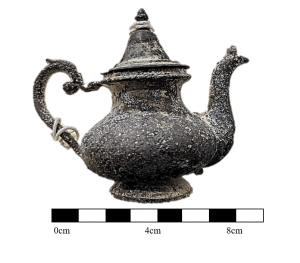
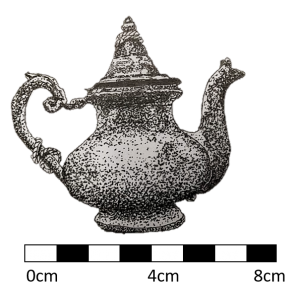
Artifact No. SP2014.001.107 is a small metal Victorian teapot and lid. It is silver in color with patches of white and green corrosion. It also has a delicate curved handle and spout. The handle itself is ornately crafted with a c-scroll feature that attaches to the lip of the teapot. The artifact is 7.3 centimeters tall, nearly 9 centimeters in width, and has a diameter of 5 centimeters at the base. The teapot is intact and in relatively good condition with small areas of concretion, particularly along the crevices. The base is slightly bent on the spout side, which causes the object to sit tilted toward the handle side. The lid of the teapot is removable and can rest snuggly within the lip of the teapot. There are also thin, faint banners along the perimeter lid. Lastly, along the handle and spout sides are makers seams.
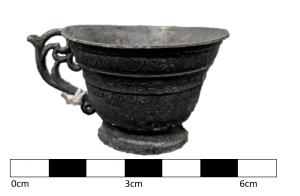
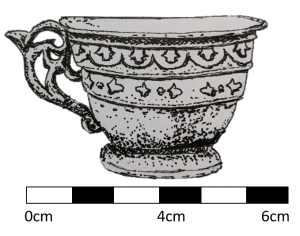
Artifact No. SP2014.001.109 is a small metal cup with an ornate handle and base. The artifact is about 3 centimeters tall, 6.5 centimeters wide, with a diameter of 5 centimeters at the base. It has three distinct decorated patterns around the outside of the object. After examining the patterns, the uppermost banner resembles a wreath-like design with fleur-de-lis symbols within each arc. The middle pattern appears to have a faint fleur-de-lis banner that wraps the circumference of the artifact. Lastly, the bottom-most banner is highly eroded and barely visible. The handle of this artifact is the most ornate out of the tea set. The handle branches into three swirls that then attach to the side of the cup near the lip. The cup itself is mostly intact, however, it is cracked along the bottom of the base where it meets the curve of the cup, causing three gaps. The cup’s lip is slightly uneven, and according to the curation record, it appears to have been crushed and warped. Much like the teapot, this artifact also has two makers seams along the edges.
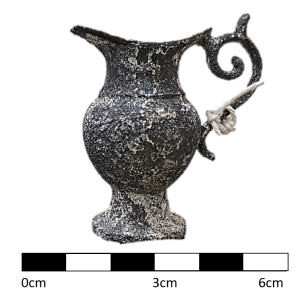
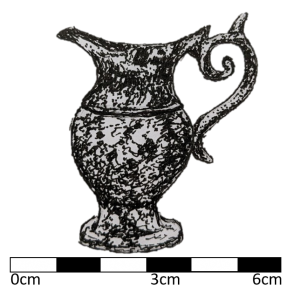
Artifact No. SP2014.001.110 is a miniature metal pitcher that matches the style and make of the Victorian teapot. It is also the smallest artifact in the set with a height of 5 centimeters, a width of 4.7 centimeters, and a diameter of 2 centimeters at the base. The artifact is grey in color with a wide spout, round base, and a handle that resembles the same c-scroll feature as the teapot. The pitcher is primarily intact and stable, however, it is covered with white and green concretions both inside and outside the vessel. The spout and base are chipped and uneven. There are also faint impressions of a banner along the neck. These features are heavily eroded. Again, like the previous two artifacts, there are two makers seams along opposite sides of the artifact.
References and Acknowledgements
2012 Steamer City of Houston. North Carolina Shipwrecks. <http://northcarolinashipwrecks.blogspot.com/2012/05/steamer-city-of-houston-23-october-1878.html>. Accessed 15 March 2021.
Special thanks to the curation and collections staff of the North Carolina Maritime Museum in Beaufort. For more information, check out their website at ncmaritimemuseumbeaufort.com.
– Amber Cabading
